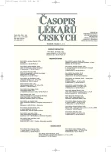Problems with placement and using of automated external defibrillators in Czech Republic
Authors:
Tomáš Olos 1,2; Filip Burša 3; Roman Gřegoř 1; David Holeš 1
Authors‘ workplace:
Územní středisko záchranné služby Moravskoslezského kraje
1; Oddělení pediatrické resuscitační a intenzívní péče – KDL, FN Ostrava
2; Anesteziologicko-resuscitační klinika, FN Ostrava
3
Published in:
Čas. Lék. čes. 2011; 150: 494-498
Category:
Enlarged Case Report
Overview
The use of automated external defibrillators improves the survival of adults who suffer from cardiopulmonary arrest. Automated external defibrillators detect ventricular fibrillation with almost perfect sensitivity and specificity. Authors describe the use of automated external defibrillator during cardiopulmonary resuscitation in a patient with sudden cardiac arrest during ice-hockey match. The article reports also the use of automated external defibrillators in children.
Key words:
automated external defibrillator, out-of-hospital cardiac arrest, layperson resuscitation.
Sources
1. Klener P, et al. Vnitřní lékařství. Praha: Galén 2001.
2. Larsen R. Anestezie. Praha: Grada Publishing 2004.
3. Larsen MP, et al. Predicting survival from out-of-hospital cardiac arrest: a graphic model. Ann Emerg Med 1993; 22: 1652–1658.
4. Waaljewingh RA, et al. Survival models for out-of-hospital cardiopulmonary resuscitation from the perspectives of the bystander, the first responder, and paramedic. Resuscitation 2001; 51: 113–122.
5. Alem van AP, et al. Use of automated external defibrillator by first responders in out of hospital cardiac arrest: prospective controlled trial. BMJ 2003; 327: 1312–1317.
6. Hoke RS, Chamberlain DA, Handley AJ. A reference automated external defibrillator provider course for Europe. Resuscitation 2006; 69: 421–433.
7. Roppolo LP, et al. Prospective, randomized trial of the effectiveness and retention of 30-min layperson training for cardiopulmonary resuscitation and automated external defibrillators: The American Airlines Study. Resuscitation 2007; 74: 276–285.
8. Einspruch EL, et al. Retention of CPR skills learned in a traditional AHA Hearthsaver course versus 30-min video self training: a controlled randomized study. Resuscitation 2007; 74: 476–486.
9. Lynch B, et al. Effectiveness of 30-min CPR self-instruction program for lay responders: a controlled randomized study. Resuscitation 2005; 67: 31–43.
10. Abella BS, et al. Untrained Volunteers Perform High Quality CPR When using an Automatic External Defibrillator with a CPR Voice Prompting Algorithm. Circulation 2007; 116 (2): 437.
11. Mosesso VN Jr, et al. Effects of AED device features on performance by untrained laypersons. Resuscitation 2009; 80(11): 1285–1289.
12. Lichter PA, et al. System to improve AED resuscitation using interactive CPR coaching. Conf. Proc. IEEE. Eng Med Biol Soc 2009; 6755–6760.
13. Nolan JP, et al. European Resuscitation Council Guidelines for Resuscitation 2010. Section 1. Executive summary. Resuscitation 2010; 81: 1220.
14. Rothmier JD, Drezner J, Harmon JG. Automated external defibrillators in Washington State high schools. Br J Sports Med 2007; 41: 301–305.
15. Meredith M. Sudden cardiac arrest in Tennessee high schools. The American Academy of Pediatrics National Conference and Exhibition, Boston 2008.
16. Kämäräinen A. Out-of-hospital cardiac arrests in children. J Emerg Trauma Shock 2010; 3(3): 273–276.
17. Parck CB, et al. Pediatric out-of-hospital cardiac arrest in Korea: A nationwide population-based study. Resuscitation 2010; 81(5): 512–517.
18. Lofti K, et al. Cardiac arrest in schools. Circulation 2007; 116: 1374–1379.
19. Berger S, Cardiopulmonary resuscitation - automated external defibrillation programs for children and adolescents: Is public access defibrillation directed at our youth justifiable? Paediatr Child Health 2009; 14(3): 183–184.
20. Berger S, et al. Cost-effectiveness of Project ADAM: A project to prevent sudden cardiac death in high school students. Pediatr Cardiol. 2004; 25: 660–667.
21. Bar-Cohen Y, et al. First appropriate use of automated external defibrillator in an infant. Resuscitation 2005; 67: 135–137.
22. Divekar A, Soni R. Successful parental use of an automated external defibrillator for an infant with long-QT syndrome. Pediatrics 2006; 118: 526–529.
23. Atkins DL, Jorgenson DB. Attenuated pediatric electrode pads for automated external defibrillator use in children. Resuscitation 2005; 66(1): 31–37.
24. Journal Article. Automated external defibrillation by first-responders.Prescrire Int 2010; 19(107): 126–129.
25. Hanefeld C. A first city-wide early defibrillation project in a German city: 5-year results of the Bochum against sudden cardiac arrest study. Scand J Trauma Resusc Emerg Med 2010; 15: 18–31.
26. Winkle RA. The effectiveness and cost effectiveness of public-access defibrillation. Clin Cardiol 2010; 33(7): 396–399.
27. Folke F, et al. Location of cardiac arrest in a city center: strategic placement of automated external defibrillators in public locations. Circulation 2009; 11; 120(6): 510–517.
28. Foutz RA, Sayre MR. Automated external defibrillators in long-term care facilities are cost-effective. Prehosp Emerg Care 2000; 4(4): 314–317.
29. Pell JP, Walker A, Cobbe SM. Cost-effectiveness of automated external defibrillators in public places. Curr Opin Cardiol 2007; 22(1): 5–10.
30. Portner ME, et al. Out-of-hospital cardiac arrest locations in a rural-community: where should we place AEDs? Prehosp Disaster Med 2004; 19(4): 352–355.
31. Frank RL, et al. The locations of nonresidential out-of-hospital cardiac arrests in the City of Pittsburgh over a three-year period: implications for automated external defibrillator placement. Prehosp Emerg Care 2001; 5(3): 247–251.
32. Larsen R. Anestezie, 7. přepracované a rozšířené vydání. Praha: Grada Publishing 2004.
33. Truhlář A. Kde je umístěn automatizovaný externí defibrilátor? Urg med 2010; 2: 6.
34. Einay S, Weissman C, Kark J. Future shock: automatic external defibrillators. Curr Opin Anaesthesiol 2005; 18(2): 175–180.
35. Truhlář A. Česká resuscitační rada – nová organizace založena s podporou ČSARIM a ČSIM. Čas Anesteziologie a intenzivní medicína 2010; 6: 385.
Labels
Addictology Allergology and clinical immunology Angiology Audiology Clinical biochemistry Dermatology & STDs Paediatric gastroenterology Paediatric surgery Paediatric cardiology Paediatric neurology Paediatric ENT Paediatric psychiatry Paediatric rheumatology Diabetology Pharmacy Vascular surgery Pain management Dental HygienistArticle was published in
Journal of Czech Physicians

Most read in this issue
- Human dignity and medical ethics
- Strategic dominance of the mucosal immune system in the defence and tolerance
- Problems with placement and using of automated external defibrillators in Czech Republic
- Perspectives of health care and system of health services
